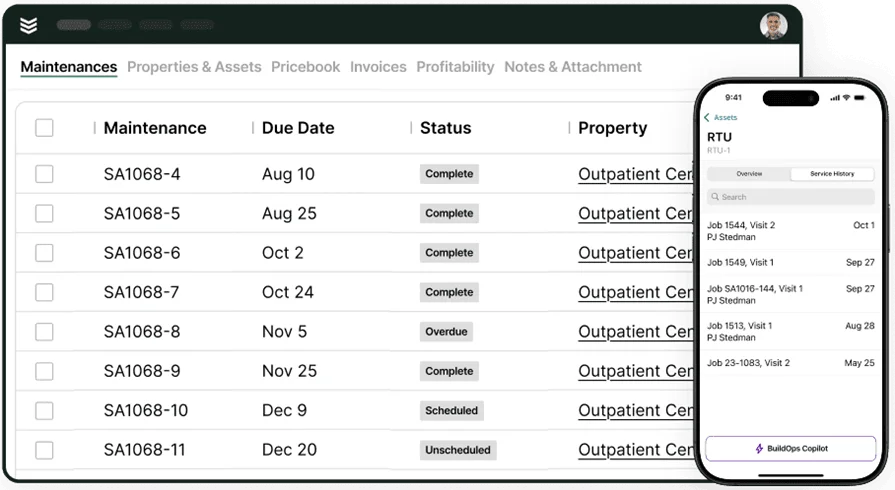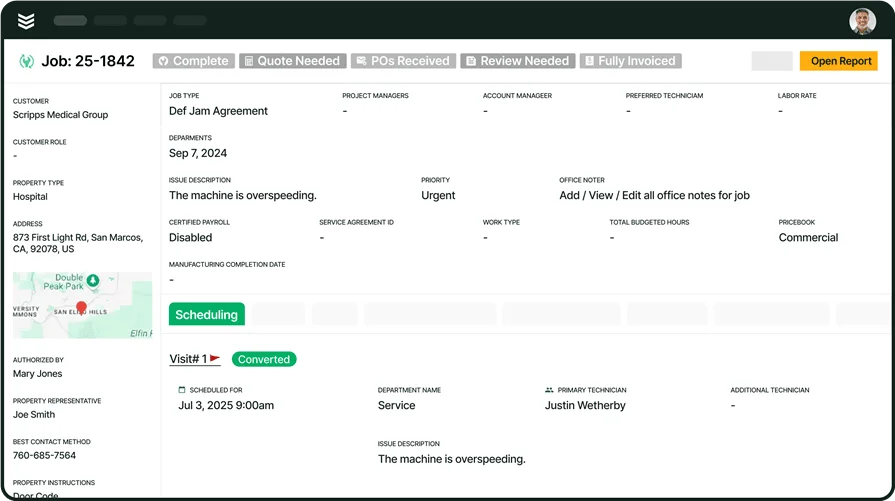Manual ticket logs and clunky spreadsheets aren’t cutting it anymore. For techs in the field juggling service calls, repairs, and customer updates, having reliable work order tools on hand can make or break the day. That’s why so many crews are looking into free work order software options they can actually control—without the bloat or cost of big-name systems.
From managing repeat maintenance jobs to tracking last-minute fixes, work order management software free tools let you build a system around how your crew actually works. And if your team’s got the technical chops, work order management software open source options go even further—letting you shape features, flows, and reports around the real job site grind.
To help you figure out which setup works best, we’re breaking down the pros, features, and top tools available. Want a look at how it fits inside broader operations? Check out this full breakdown of field service management for context on how these tools plug into the bigger picture. Here’s what we’ll cover:
- How to choose a free work order management software
- 6 key features to look for in free work order management software
- 7 best free work order software & management tools
- 8 benefits of using open source work order software
- 4 important FAQs for free work order software answered
Before diving into platforms and feature lists, it helps to know what you’re solving for. Every crew works differently. So the goal isn’t picking the flashiest tool—it’s finding (or shaping) one that keeps jobs moving without slowing down your team. Let’s start with how to size up what you really need.
How to choose a free work order management software
Out in the field, your work order system needs to move as fast as your team does. Techs don’t have time to wrestle with laggy apps or missing job info. The right free work order software makes sure every step—from dispatch to closeout—happens without friction. Whether you’re logging fixes, tracking maintenance, or jumping between sites, the tool you pick should fit your crew, not the other way around.
Here’s how to figure out which work order management software free setup actually works in the real world.
- Crew readiness – Who’s going to manage the tool? Does someone on your team know how to set it up and handle tweaks down the line? Will you need a tech-savvy partner or outside help? Can you test it with a small group before going all-in?
- Workflow control – How much flexibility do you need? Can you customize task fields, job flows, or user roles? Does it let you work around your process—not force you into theirs? Can your team make updates without waiting on a vendor?
- Budget match-up – Where can you cut costs? Will switching to work order software free cut down licensing or subscription fees? Are you okay trading bells and whistles for long-term savings? What other costs—like add-ons or training—should you expect?
- Tool compatibility – Will it fit into your current setup? Does it connect to your scheduling, invoicing, or CRM tools? Will switching disrupt anything your techs already rely on? Can the system pull in existing data without making a mess?
- Features – Does it do what your crew needs it to? Can techs log job details, upload photos, and update work orders from the field? Does it work without a signal? Does this free work order management software cover the day-to-day or just scratch the surface?
Next, we’ll break down the exact features that matter most—so you’re not guessing what you’re missing once your team’s already out on the job.
6 key features to look for in free work order management software
When you’re running jobs in the field, work orders are the heart of the operation. They tell your crew what to fix, where to go, and what’s been done before. If your Field Work App doesn’t handle that cleanly, things fall apart—jobs get missed, info gets lost, and teams waste time chasing answers. The features below aren’t just about functionality—they’re about making free work order software actually work for crews on-site.
1. Scheduling and dispatching
Every work order starts with the schedule. Your app should make it easy to assign jobs and shift them as things change throughout the day. Tools like field service scheduling and dispatch software let dispatchers see who’s available and get work orders out without a dozen calls or texts. Say your first job of the day runs long, and another tech finishes early—your dispatcher shifts the new work order over in seconds. The tech sees it, taps to accept, and keeps the day moving without missing a beat.
2. Mobile CRM access
A work order without context is just a task list. With CRM software, your Field Work App pulls in customer history, past work orders, and equipment details—so techs have the full picture when they show up. Let’s say a customer’s system keeps throwing the same error. Your tech checks the last three work orders, sees the pattern, and fixes the root issue instead of just resetting the unit again.
3. Fleet and asset tracking
Work orders aren’t just about what’s broken—they’re about getting the right people and tools to the site. Fleet tracking software helps dispatchers assign jobs based on location, availability, and vehicle status. If a work order pops up for a rooftop unit across town, and one truck’s still stuck in traffic, your team can send another nearby. That work order stays on schedule, and your techs aren’t racing the clock just to stay caught up.
4. Invoicing and payment tools
The work order’s done—but if the invoice is delayed, the job’s not really complete. Invoicing tools and payment software built into Field Work Apps let techs close out jobs on-site. For example, after replacing a blower motor, your tech finishes the work order and immediately sends the invoice to the customer. They pay by card on the spot, and everything gets logged back to the job. No paper trail, no lost payments.
5. Quoting and upsell capability
Sometimes a work order leads to another opportunity. With quoting software, techs can create quotes directly from the app—using data from the current job. Let’s say during a standard repair, your tech spots a corroded pump that’s about to fail. Instead of calling it in and waiting, they price out the replacement, send a quote, and the customer approves it—all while still on-site. The new work order’s already lined up.
6. Reporting and job tracking
The real value in work order management software free tools is knowing what’s actually happening out there. With reporting software, you can review trends across job types, technician efficiency, and delays. Maybe your team’s been getting bogged down on one type of work order. You dig into the reports and find those jobs are missing prep notes. A small fix in how work orders are issued gets your average time per job back under control.

Streamline work order management
Keep jobs moving smoothly so you can get more done and boost revenue.
Other notable features to look for in an open-source work order solution
While the first six features keep your work orders running in the field, there are a few more tools that can round out a work order management software open source setup. These extras aren’t mission-critical, but they can make your workflows cleaner, faster, and easier to manage—especially as your operation grows.
- Recurring service agreements - If you handle preventative maintenance or long-term service deals, managing contracts through the app helps automate future work orders. Service agreement management tools can schedule recurring jobs, track contract terms, and alert your team about upcoming visits—so nothing slips through the cracks.
- Time tracking tools - Clocking job hours manually is a headache. Integrated time tracking software ties labor directly to each work order. That way, you know exactly how long jobs take and where your techs are spending their time—helping with payroll, billing, and efficiency reviews.
- Lead pipeline visibility - Some jobs start as leads, not scheduled work. With pipeline tracking tools, you can track every opportunity from first inquiry to closed work order. This helps sales and service stay aligned—especially for install jobs or long-cycle service bids.
Whether you need all of these or just a few depends on how your team runs. What matters is that your free work order software gives you the choice to grow into these tools without locking you into a boxed system. Next, we’ll walk through the top open source platforms available today—and which types of teams they actually work best for.
7 best free work order software & management tools
Not every field service crew works the same—and that’s exactly why work order management software open source platforms exist. Some teams need full control over scheduling and reporting. Others want something lightweight they can tweak to fit simple job flows. The tools below give your team flexibility without starting from scratch. Each one is open source or free to use, and each fits a specific type of work order environment.
1. Best for commercial: BuildOps
BuildOps is built for commercial contractors who manage complex work orders across multiple trades, sites, and job types. It brings scheduling, dispatch, quoting, asset tracking, and job status into one unified system—designed for companies that need accuracy at scale. It’s especially strong for teams that juggle heavy service schedules and want to track jobs from dispatch to invoicing without dropping the ball.
How pricing works: BuildOps offers custom pricing based on company size and feature needs.
Why open source is better: For large teams, having access to deeply customizable features gives them a leg up—without waiting on vendor timelines or paying extra for changes.
What sets it apart: BuildOps supports high-coordination operations with mobile tools and real-time tracking across work order types.

Explore our FSM suite
We combine dispatch, work order tracking, and quoting for better job management.
2. Best for residential: Housecall Pro
Image Source: Housecall Pro
Housecall Pro is designed for residential service contractors looking for simple tools that help manage day-to-day work orders. The app makes it easy to schedule visits, send invoices, and stay in touch with customers—all from a mobile device. It’s ideal for single-tech or small-team businesses needing to complete high-frequency, low-complexity jobs quickly. However, it may not be the best fit for teams needing more complex workflow automation or deep system customization.
How pricing works: Free plan available for basic job scheduling and invoicing.
Why open source is better: If your team outgrows the free tier or needs to adjust flows for larger jobs, open source tools give you that flexibility.
What sets it apart: Housecall Pro works well for quick service jobs, simple quoting, and keeping small crews in sync.
3. Best for general contractors: Field Complete
Image Source: Field Complete
Field Complete offers general contractors a clean, mobile-first platform to manage varied job types. Its focus is speed and simplicity—scheduling, task tracking, and updates are all handled from a field-ready interface. Great for techs on the go who don’t want to wade through menus to get the next job started. That said, it may not suit operations that need in-depth reporting, integrations, or role-based permissions at scale.
How pricing works: Free for small teams, with optional upgrades based on usage.
Why open source is better: Going open source lets contractors shape flows around real project timelines—especially when managing subs, shifting roles, or customizing job stages.
What sets it apart: Field Complete nails the basics for mobile crews handling both quick calls and longer project-based work orders.
4. Best for industrial maintenance: Fiix
Image Source: Fiix
Fiix offers a cloud-based CMMS platform with open APIs and solid mobile support, making it a strong choice for industrial service teams handling reactive and preventive maintenance. Its work order system connects to asset data, inventory, and maintenance logs—all in one place. But while it’s strong for internal asset teams, it may not be the best match for contractors handling client-facing field work or dynamic job routing.
How pricing works: Free plan includes core CMMS tools and unlimited work orders for small teams.
Why open source is better: Open source platforms allow for more control over how work order data connects across client systems, tools, and integrations.
What sets it apart: Fiix is built for facilities and plants managing repeat service jobs, inspections, and asset-heavy workflows.
5. Best for enterprise service teams: Fieldpoint
Image Source: Fieldpoint
Fieldpoint focuses on large-scale field service operations with strong integration options for accounting, project management, and ERP platforms. It handles complex service calls, recurring work orders, and resource tracking—especially for companies that juggle service, install, and construction. However, it may not be ideal for smaller contractors looking for a simpler, more focused solution.
How pricing works: Offers a free trial; enterprise pricing model after trial ends.
Why open source is better: For teams wanting full customization across modules, open source removes vendor limits and supports long-term adaptability.
What sets it apart: Fieldpoint is best for organizations needing work orders to connect directly into broader systems like financials and inventory.
6. Best for fast deployment: Limble CMMS
Image Source: Limble CMMS
Limble is designed to get small-to-midsize teams up and running quickly. Its clean UI and templated workflows make it easy to log, track, and close work orders without needing deep setup. It's ideal for operations teams that need to digitize fast but don’t require complex configuration. Still, it may not scale well if you plan to heavily modify backend logic or tie in custom apps.
How pricing works: Free version available for basic users and single-site teams.
Why open source is better: With open source, you can build more around your workflow as it evolves—without relying on fixed update cycles or feature gates.
What sets it apart: Limble keeps things streamlined and easy to manage for field service teams just starting to move off paper or spreadsheets.
7. Best for asset-intensive field teams: Hexagon
Image Source: Hexagon
Hexagon supports complex field operations with powerful work order tracking tied to asset lifecycle data. It’s used heavily in industries like utilities, telecom, and infrastructure, where each work order is tied to service history, compliance rules, or GIS data. That said, it may be too feature-heavy for smaller teams who just need fast job management in the field.
How pricing works: Free tier available for small field teams with limited seats.
Why open source is better: Open systems let you trim down the complexity and shape the tech stack around what your field techs actually use.
What sets it apart: Hexagon helps large-scale teams track detailed work order history on long-life assets—from installation through retirement.

Download the software scoresheet
Easily compare leading software options so you can choose the right fit for your crew.
8 benefits of using open source work order software
Choosing free work order software—especially if it’s open source—means you’re giving your team tools they can shape and grow into without locking into a vendor’s roadmap. Beyond just cutting costs, these platforms give field service contractors more freedom to work how they want and adjust over time as the business shifts. Below are eight practical, field-ready benefits that actually make a difference.
1. Control over ticketing and job flow
Free and open source tools let you own the entire job lifecycle—from work request to closeout—without waiting on vendor changes. Your team can structure the flow of tickets and customize fields around how they work on site. When the way tickets are captured affects job outcomes, this kind of flexibility is key. That’s why having a field service ticketing system built into your setup helps techs stay clear on tasks, timing, and job expectations from the start.
2. Transparent job performance data
When you're managing work orders across dozens of job sites, you need real data—fast. Open source platforms give full access to reporting logic, so you can tailor dashboards around the metrics that matter. You’re not stuck with canned views. That’s a big win for teams who rely on performance history to schedule smarter. Learn how field service reporting can show where the gaps are before they become missed jobs.
3. Insight into crew and workflow trends
Over time, the real power of open platforms comes from their ability to surface long-term patterns. From missed appointments to overtime spikes, custom analytics let you make operational changes backed by data. You’re not just tracking jobs—you’re learning from them. If you're building your own dashboards or layering in scripts, understanding field service analytics helps you measure what’s actually happening across jobs, crews, and service zones.
4. Smarter dashboard customization
Your crew doesn’t need to see everything—just what matters. Open source setups give you control over layout, widgets, and visibility settings, so work order dashboards reflect the real needs of the field and back office. Whether it’s technician KPIs or job backlog heatmaps, field service dashboards let you visualize information in ways that speed up decision-making without adding extra admin.
5. Flexible scheduling that adjusts with you
Open platforms don’t box you into a rigid calendar or dispatch model. You can integrate with your own time logic, adjust job buffers, or create priority systems based on customer type or location. That’s tough to do with fixed SaaS tools. With a good setup, your field service scheduling evolves with how your team moves, not the other way around.
6. More responsive dispatch decisions
One of the quiet strengths of open source software is the ability to respond fast without running every change through support. If a crew calls in from the field, you can reassign, reroute, or re-prioritize jobs directly in the tool. That flexibility keeps work orders moving when the day changes unexpectedly. A sharp field service dispatching process can make or break your daily efficiency, and open platforms let you own that process completely.
7. Long-term cost efficiency
Beyond just being free up front, open source work order tools save money over time. No seat licenses. No upgrade fees. No surprise limitations. You decide where to invest—whether that’s in technical setup, integrations, or data hosting. That flexibility puts the budget back in your control, especially for crews scaling up or adjusting job volume seasonally.
8. Community-driven development and support
With proprietary systems, you wait for fixes. With open source, you can solve issues yourself—or tap into a global network of users and developers facing the same challenges. That shared knowledge speeds up problem-solving, whether it’s a workflow bug or a feature add. The benefit? Faster updates, smarter fixes, and more relevant tools over time.
4 important FAQs for free work order software answered
For field service techs, the software you rely on in the field can either speed up the day—or stall it. That’s why understanding the difference between free work order software and paid versions matters. Free options give smaller crews a chance to digitize without the cost barrier, but they often come with limits on customization, reporting, and automation.
On the other hand, work order management software open source tools offer both freedom and flexibility—letting you build around how your crew actually works, not the other way around. These FAQs cover the questions techs and service leads ask most when picking a platform for the field.
1. What is free work order software?
Free work order software helps field teams create, assign, and complete jobs without relying on paper or calls to the office—without the licensing costs of paid platforms. It usually covers basic job tracking, scheduling, and closeout steps, and are often offered in free tiers by larger platforms.
Work order software free setups are great for small teams looking to upgrade from spreadsheets but may require tradeoffs in features or support. When those free tools are also open source, it means you can modify the software itself to match how your crew works. That includes customizing job flows, syncing with your CRM or invoicing system, and building reports that show what’s happening out in the field.
2. How does free work order software work?
Most work order management software free platforms run on cloud-based systems that your techs access through a mobile app or browser. In open source setups, teams can host the software themselves and directly modify how tasks, tickets, and job stages flow from creation to completion. Here's what that can include:
- Hosting the system on your own server or private cloud
- Adjusting backend logic to match your actual workflows
- Syncing with tools like accounting, dispatching, or CRM platforms
- Updating modules and views without waiting on vendor releases
This gives techs more power to close out work orders in real time—while keeping managers informed without extra admin work.
3. When does paying for work order software become worth it?
Paid software starts to make sense when your team outgrows the limits of free platforms. That could mean hitting user caps, needing advanced reporting, or wanting deeper integrations with your accounting, CRM, or scheduling tools. If you’re burning time piecing together workarounds—or if techs are getting slowed down by the system—it’s time to consider investing.
Teams often make the jump when they need support that actually responds, or when job complexity demands a tighter tech stack. At that point, what you pay for isn’t the software itself—it’s fewer dropped jobs, less back-and-forth, and better visibility into how your field crew is performing.
4. Best practices for using free work order software in the field
Getting the most from your free work order management software doesn’t stop at setup—it’s about how your team uses it daily. Here are 10 best practices that keep your system fast, accurate, and aligned with field needs:
- Always assign a job owner so there’s no confusion on who’s responsible
- Include estimated job time and priority in each work order
- Add photos or notes before and after completing each job
- Sync all updates before leaving the site to ensure records are accurate
- Use tags to help search and filter recurring job types
- Set up alerts for overdue or high-priority work orders
- Keep customer info linked to every job for better service tracking
- Review work order history before starting repeat service calls
- Standardize job checklists so every tech follows the same process
- Use mobile apps with offline support in case of signal loss in the field
Free tools have their place—especially when your crew just needs something to get jobs logged and moving. But free doesn’t always mean fit-for-purpose. For field service contractors handling dozens—or hundreds—of work orders a month, the real challenge isn’t just tracking the job. It’s keeping every piece connected: scheduling, dispatching, customer records, asset history, invoices. When those parts live in separate systems, your team ends up doing more patchwork than actual fieldwork.
That’s where open source options step in. They offer flexibility, customization, and a chance to build around how your operation actually runs. But they also demand time, tech know-how, and a clear plan to scale. And for contractors running commercial jobs or managing teams across multiple sites, those tradeoffs can slow you down fast.
Sometimes what you really need is a field-ready system that ties everything together without creating new problems. A system built specifically for field service, not adapted to it. That’s why teams ready to grow often look past free solutions toward platforms that bring scheduling, quoting, reporting, and job tracking into one clean package. And that’s exactly where BuildOps stands apart—as an all-in-one solution made for commercial contractors who need real coordination without the clutter.

Curious how BuildOps compares?
See how our FSM software helps teams manage jobs from the very first call.








